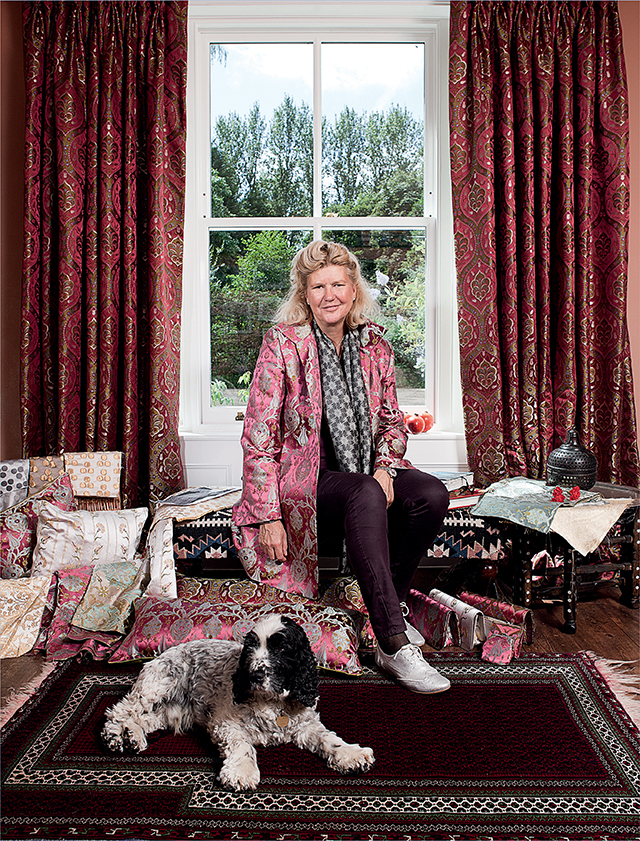Sumptuous and richly patterned Turkish fabric used to be the sine qua non of silk weaving. Can it be restored to its former glory?
When Ros Pollock recently showed her new collection of jacquard-woven fabric Ottoman Silks to an interior designer, she was slightly taken back when asked why she’d named the collection after a type of footstool. ‘Perhaps I shouldn’t have been that surprised the Ottoman Empire doesn’t seem to appear much on the school history curriculum here in the UK,’ she laments.

Ros Pollock hopes that her company can keep the art of Turkish silk- weaving alive and put the material ‘back on the high-quality fashion map’
In 2011, her own education in it deepened when the self-confessed ‘serial entrepreneur’ moved with her husband, Andrew, who works for the UN, from one posting in Jerusalem to another in Ankara. ‘We sent our daughter, Georgina, who was 12 at the time, to the British Embassy school, 100 yards away from our flat, and our arrival coincided with the beginning of the Arab Spring when Syria was starting to blow up, so Andrew became very involved in that and I had a bit of time on my hands,’ explains Mrs Pollock.
Without a background in fabrics she’d previously worked in corporate hospitality and music production but with an interest in developing something locally, her eye was drawn to Turkish patterns. ‘I began to notice all these fantastic designs repeated in various aspects of Turkish life from cushions and upholstery to china and scarves and I thought someone must be producing them in the authentic silk that the Ottomans were famous for.’
After searching high and low throughout the Grand Bazaar (‘full of junk mostly made in China’) and elsewhere in the country including the markets of Bursa, the capital of silk-weaving in Turkey she hit a dead end. ‘Not only did I discover that no one was making these patterns in silk, but, more importantly, the art of silk-weaving was dying out in Turkey. It occurred to me and my Turkish-speaking business partner, Carol Karadag, that if we could somehow get a business off the ground producing authentic Turkish silk and using some of the traditional designs recovered from the sultans’ tombs, this could, in turn, help to stem the decline of this craftsmanship.’
Her research took her to the archives of the Topkapi Palace in Istanbul, the Textile Museum in Washington DC and the V&A in London. At the height of the Ottoman Empire, during the 15th and 16th centuries, when its influence spread from North Africa up to the Balkans, the sultans were so rich that they had an area of the Topkapi Palace dedicated to hand-weavers, who were commissioned to make a multitude of designs from which the sultan would choose his favourites. He would then dress his Court in his designs. Pieces of this silk, a metre of which took eight months to weave, became so valuable that they were traded as currency and used as diplomatic gifts throughout Europe, which is how they ended up in London.
When the sultan died, his clothes were wrapped in a bundle and labelled, sealed and stored in the Treasury of the Guards. At the turn of the century, when the Ottoman Empire was in rapid decline, many of these were unwrapped, but it wasn’t for many years that they were fully documented and their value came to the fore.
In her search for a base from which to put into production a few early designs borrowed from sultans’ kaftans, Mrs Pollock came across a school set up by Ataturk in the 1930s precisely to preserve Turkish craftsmanship. ‘It’s like a massive comprehensive school for girls to learn everything from felt-making to ceramics, embroidery and dressmaking and, today, it dresses most of the ministers’ wives within the Turkish government,’ she says. ‘But it feels like all this talent is beavering away without a home—all they have is a tiny shop. It’s very Turkish in its outlook, by which I mean far from entrepreneurial.’
Mrs Pollock and Mrs Karadag set up Ottoman Silks, using Turkish weavers, leatherworkers, printers and tailors—everyone down to the photographer and website designer is Turkish and purposefully so. ‘We really hope that the success of the company will increase demand for silk-woven products from Turkey and help rescue this skill-set from dying off,’ explains Mrs Pollock.
The collection, which includes Amina, an intricate staggered ogival lattice of tulips and medallions, and Ayse, floral vertical bands of tulips and carnations framed by double gold stripes, copied directly from original kaftans, has found a natural market with buyers from Russia and Saudi Arabia, who find the silks at once familiar and unique.
The company is currently working with Susan Bottomley of Jane Bottomley Interiors (020–8355 3388; www.janebottomleyinteriors.co.uk) to reproduce these patterns in classic taupes, creams and golds to appeal to classic London and country-house tastes. ‘The fabric is absolutely beautiful,’ explains Mrs Bottomley, who trained at Colefax & Fowler before taking on her mother’s business in the early 1980s. ‘It’s weighty and has lots of body and, because it’s a jacquard, you get the undulations that capture the light in a way other material can’t. Although it’s not necessarily appropriate for a family room, its richness can really add a decadent look in a formal drawing or dining room.’
In Mrs Bottomley’s opinion, Turkey needs to do a ‘PR job’ on its fabrics. ‘A lot of the designer labels that you buy from France or Italy have, in fact, been made in Turkey and then rebranded,’ explains Mrs Pollock. ‘But a lot of designs that we know today originated in the Ottoman Empire. Liberty’s paisley, for example, came from Persia. We hope that, in some small way, Ottoman Silks can help put this wonderful craftsmanship back on the high-quality fashion map.’
For further information, telephone 01483 565949 or visit www.ottomansilks.com





